From Bloomberg Businessweek to The 74, it’s now an annual tradition to share a journalism “Jealousy List” — a tribute to the most memorable and impactful coverage published by other outlets.
In short, it’s a list of stories we wish we’d covered.
We want to celebrate and honor the powerful stories that have shaped important conversations around our nation’s youngest children and the families, caregivers and early educators who support them.
Some of these pieces focus on the early care and education workforce, covering key issues like low wages, the challenges of subsidies, and barriers to accessing funding and benefits. Others address topics central to families, like the affordability and quality of care, the high stakes of screen time and why it’s so tough to find child care options.
Below, in no particular order, are nine stories about early care and education that we can’t stop thinking about from 2024. Kudos to the journalists who wrote them, the sources who boldly shared their experiences and ideas, and the researchers who released studies and data that informed them.
By sharing these stories, we aim to surface (or resurface) some of the most creative storytelling, impactful practices and important research in the field. We hope you’ll read — and share — them.
Many ‘Informal’ Child Care Providers Are Entitled to Pay. Most Don’t know It
Sarah Carr, The Hechinger Report
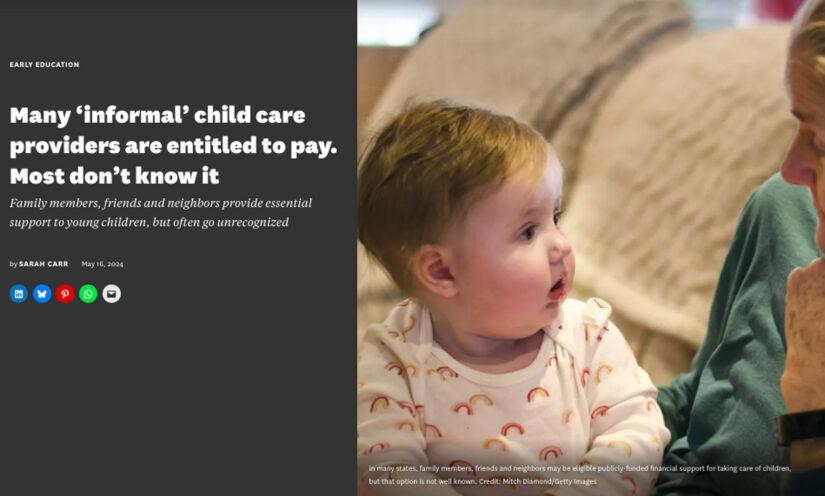
Family, friend and neighbor (FFN) care is the most prevalent form of non-parental child care in the U.S. but this critical group of child care providers often goes unnoticed and many are underpaid.
There are efforts across the country to provide more support to FFNs, but obstacles arise. In many states, for example, FFN caregivers often face barriers to accessing funds they qualify for, such as subsidies for children from low-income families.
From language barriers, to government mistrust to enrollment difficulties and more, Sarah Carr looks at the challenges facing this vast group of providers and why so many of them struggle to obtain the funding they are eligible to receive. And even when they can access the funds, Carr raises important issues like low reimbursement rates and processing delays that extend and complicate the series of hurdles for these caregivers.
What Day Care Workers and Preschool Teachers Think About Their Jobs
Six women get candid on dwindling enrollment, priced-out parents, and crying kids.
The Cut, as told to Anya Kamenetz

When it comes to early care and education, many of the stories that resonate most are about the significant cost of providing high-quality, developmentally appropriate, reliable child care — and the tough reality that while the price is often high for families, child care programs typically operate on thin margins with providers working for very low wages. That rings true in New York City, where the cost of living has soared to the point that half of the city’s households can’t afford basic needs, funding for pre-K and 3-K programs is unpredictable, and child care subsidies often fall short. Six child care workers in various settings across the boroughs shared their day-to-day experiences with Anya Kamenetz, who writes about education and parenting. Their experiences, as told to Kamenetz, shine a light on the complexities of the profession as well as their passion for the young children they serve.
America’s Child Care Crisis Is Holding Back Moms Without College Degrees
Moriah Balingit and Sharon Lurye, The Associated Press and Daniel Beekman, The Seattle Times

For many parents, especially mothers, the decision about whether to work has a number of factors, but often comes down to a simple question: Is the cost of child care greater than my take-home pay?
Nicole Slemp found herself asking this question. She expected to return to her job, which she loved, after having her son. But once she crunched the numbers, she learned that most of her salary would go to child care and found that she and her husband made too much to qualify for support from the government. She felt she had no choice but to quit.
In the U.S., where the cost of care can be prohibitive, government assistance is sparse and child care slots are limited, this story isn’t uncommon, especially for women. But while women’s participation in the workforce has increased overall, there’s a noticeable employment gap between mothers with and without a four-year degree. Moriah Balingit, Sharon Lurye and Daniel Beekman unpack that employment gap, the data behind it and the lived experiences of some of the women finding themselves faced with difficult decisions.
The Youngest Pandemic Children Are Now in School, and Struggling
Teachers this year saw the effects of the pandemic’s stress and isolation on young students: Some can barely speak, sit still or even hold a pencil.
Claire Cain Miller and Sarah Mervosh, New York Times, The Upshot
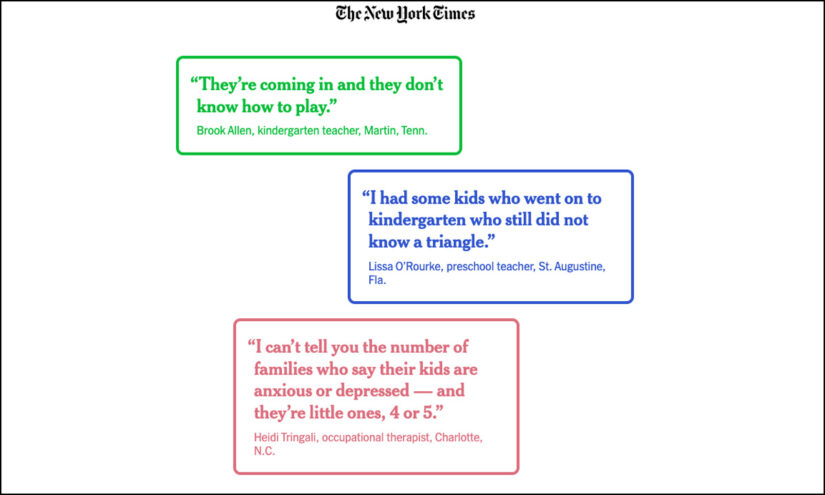
There’s been a good deal of reporting on the effects of the pandemic on older children. Less covered is the impact on the nation’s youngest children — those who were babies, toddlers and preschoolers during the height of the pandemic and are now school-aged.
Claire Cain Miller and Sarah Mervosh share findings from interviews with teachers, pediatricians and early childhood experts. The bottom line: Many of these younger children are showing signs of academic and developmental delays. There are also concerns related to a variety of areas like speech and language development, emotional regulation, social interactions, behavior, attention span, core strength and fine motor skills. Researchers suggested that a number of factors affected young children during the pandemic, including parental stress, less exposure to people, more time on screens and lower preschool attendance.
Despite these trends, some experts said recovery is possible, pointing to tools and resources that can help as well as evidence that the early years of brain development in young children positions them well to “catch up.”
What If Finding Child Care Online Were as Easy as Making a Dinner Reservation?
Emily Tate Sullivan, EdSurge

At a time when people can make dinner reservations on an app and buy a car online, it may come as a surprise that finding child care options isn’t that easy, but that’s the reality for many families.
In most states, there’s a website with information about providers, such as operating hours and quality ratings, but enrollment data is often outdated or not listed at all. Without reliable information on vacancies, a parent might spend time calling programs that are at capacity.
Some states — including Iowa, Maryland and Arizona — have teamed up with technology firms to develop solutions that help families find child care, reports Emily Tate Sullivan.
By using “near real-time” vacancy data, these efforts are saving families time and helping state leaders understand their child care systems, giving them a better sense of capacity by surfacing open slots as well as shortages. This approach, which provides more accurate data, can help state leaders, lawmakers and communities plan more intentionally, make informed decisions and direct attention where it’s needed.
Child Care Is at the Center of the Largest-Ever Fine in Women’s Soccer
Chabeli Carrazana, The 19th
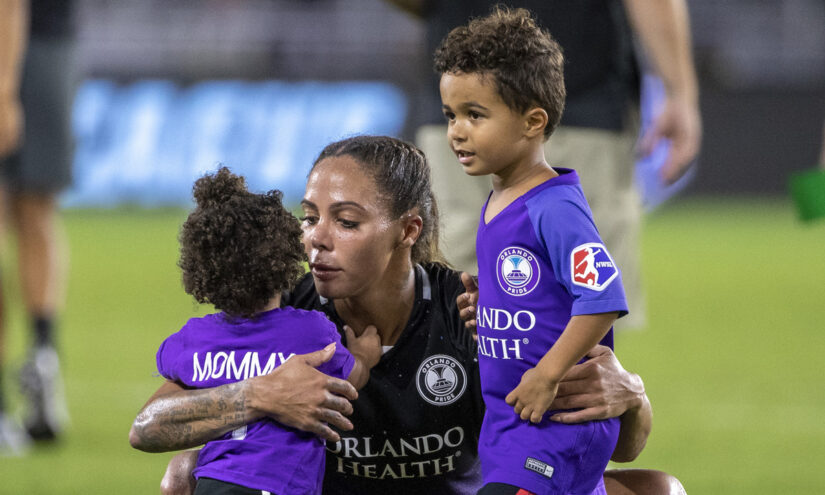
“For years, American women soccer players have been at the forefront of advocating for pay equity in a sport they dominate at a global level. But child care has long been an issue they’ve also contended with” writes Chabeli Carrazana, adding that “Some have argued that their pay and benefits simply were not enough to cover child care costs.”
Carrazana digs into a dispute between the Angel City Football Club — an American professional women’s soccer team — and the National Women’s Soccer League (NWSL).
After conducting an investigation into a salary cap violation by Angel City FC, and determining that the team had surpassed the cap through a number of agreements that were made with players directly and not disclosed to the NWSL, the league announced that it was docking three points from the team’s standings and fining the team.
While child care payments were only part of the reason the team exceeded the cap, the situation brought child care benefits for parent athletes into the spotlight, and in particular, raised a question about whether any child care payments should count against the salary cap.
Too Much Screen Time Harms Children, Experts Agree. So Why Do Parents Ignore Them?
Jenny Gold, Los Angeles Times
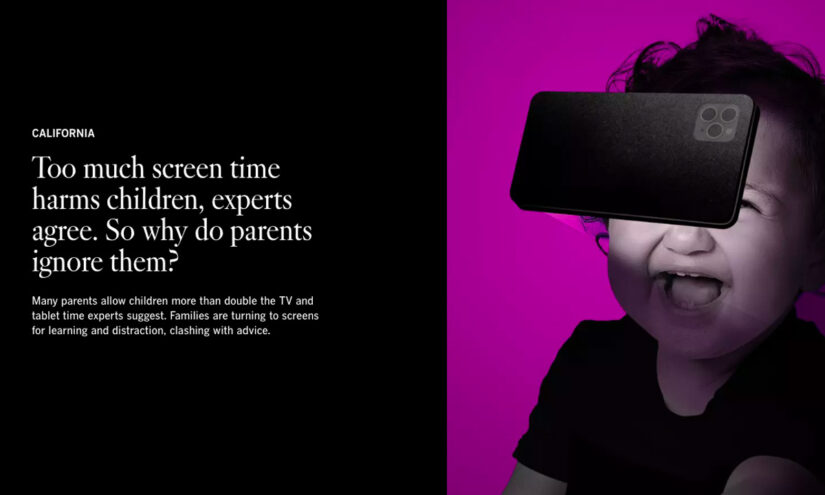
School cell phone bans are making headlines, and the U.S. surgeon general has pushed for a label on social media platforms warning families that usage of the apps could be detrimental to the mental health of adolescents. Pediatricians have raised concerns around health and development, like behavioral challenges, issues with sleep, language delays and more.
For families with young children, a major question is: How much screen time is OK? There are recommendations for children under 5 years old, but the guidance can feel overwhelming. From time limits to quality assessment to the importance of “co-viewing” digital media with young children, there’s a lot for parents to consider, and the reality is that many families aren’t meeting these guidelines.
Jenny Gold dives into the high stakes of screen time, whether limiting it is realistic given the world parents are raising children in today, and what families can do to make the most of their children’s screen time.
‘I Can Be a Mom and a Teacher’: Schools Tackle Child Care Needs to Keep Staff in Classrooms
Carly Flandro, Idaho Education News and Valeria Olivares, The Dallas Morning News Education Lab
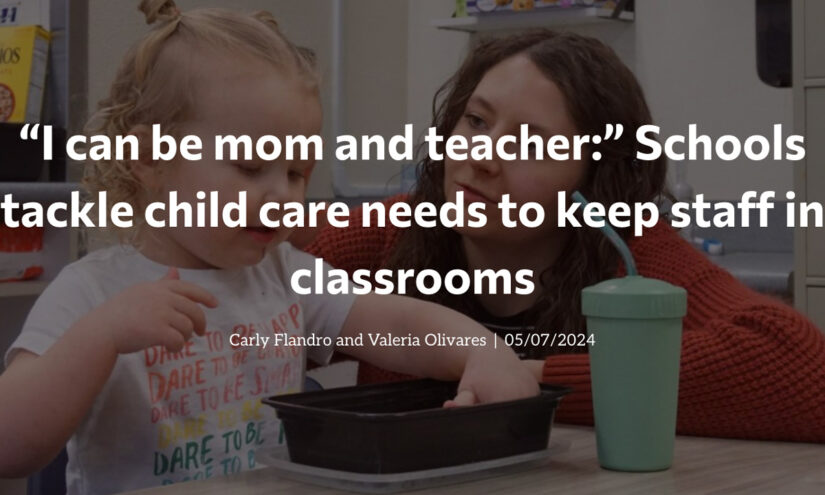
Stress. Anxiety. Financial pressure. The child care crisis is weighing on parents, especially the ones who work. Teachers aren’t immune. Many parenting teachers are faced with difficult decisions about their work lives, and child care is a major factor.
A number of schools in some states, particularly those with limited funding for early care and education, are offering high-quality, affordable child care for their teachers. This solution addresses educator retention, while aiming to help early learners become better prepared to enter kindergarten. Programs vary, but some offer care from infancy so teachers don’t have to choose between parenting and their career.
Carly Flandro and Valeria Olivares dive into two of these initiatives. One is an elementary school in Nampa, Idaho that offers on-site child care, which a dozen of the school’s 30 teachers take advantage of. The other is a Texas district that’s offering subsidized child care and that has two “child learning academies” for infants and toddlers from 6-weeks-old through age 3, that serve 120 children.
Flandro and Olivares reported that these services made a difference for teachers, whether easing the cost, helping them feel reassured their children were receiving high-quality care, or even keeping them in the classroom.
In 2024, Head Start Programs Are Still Funded By a Formula Set in the 1970s
New study reveals the extent of harms of an ‘outdated, uneven’ Head Start funding system.
Jackie Mader, The Hechinger Report
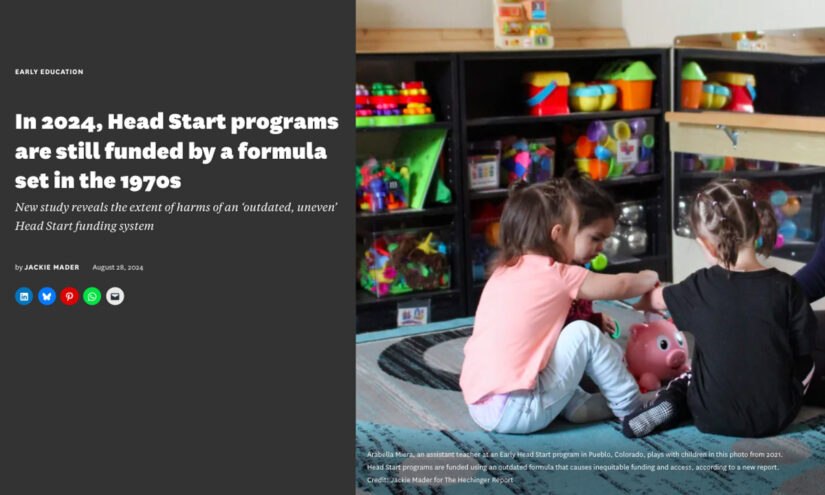
“When Head Start was established in 1965, it was meant to boost outcomes for children from low-income families by offering high-quality early learning and wraparound services,” writes Jackie Mader. Today, she adds, the program has seen increased funding, but the way that federal funding is distributed is based in part on a formula from 1974.
So what does that mean for children and families? Mader takes a look at the funding model and analyzes findings from a report by the Southern Education Foundation, which suggests that the formula should be updated to reflect changes in the definition of poverty, and to account for the number of eligible children and where they live.
Researchers say the best fix is to give Head Start a one-time increase to be spread across a few years, which could be used to even out the funding and then to adjust the formula. With a new federal rule to provide a raise to most Head Start teachers, Mader writes, researchers expressed a sense of urgency to adjust the formula. Paying staff more is key. So, too, is increasing access to serve more children.

Marisa Busch
Marisa Busch is a senior editor steering both news coverage and analysis of early education issues, childhood development, family engagement and post-COVID learning recovery.



